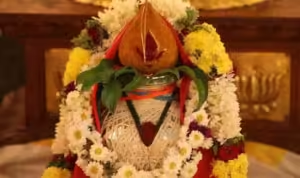Ghat Sthapana: A Step-by-Step Guide to Performing the Ritual
Ghat Sthapana, also known as Kalash Sthapana or Ghatasthapana, is a significant Hindu ritual that marks the beginning of Chaitra Navratri. This nine-day festival is dedicated to the worship of Goddess Durga and her various manifestations. If you’re planning to perform Ghat Sthapana, here’s a step-by-step guide to help you:
0. Time for Kalash Establishment (Sthapana)
In 2024, Chaitra Navratri will be observed from April 9 to April 17. The Ghatasthapana Muhurat will be on April 9, from 6:41 AM to 8:00 AM. The Abhijit Muhurat is the best Muhurat and that will be on April 9, from 12:44 PM to 1:36 PM.
1. Selecting the Kalash
Choose a brass or copper pot, known as a Kalash, for the ritual. Make sure to clean it thoroughly with water and wipe it dry.
2. Preparation of Kalash
Ghatasthapana Items
- Wide and open Clay Potto sow Sapta Dhanya
- Clean Soilto sow Sapta Dhanya
- Nav Dhanya or seeds of nine different grains
- Small clay or brass Pitcher
- Sacred water to fill the Kalash or Ganga Jal
- Sacred thread / Moli / Kalaya
- Scent(perfume)
- Supari(betel nuts)
- Coinsto put into the Kalash
- Five leavesof Ashoka or Mango tree
- A Lidto cover the Kalash
- Raw Riceor unbroken rice known as Akshat (अक्षत) to put in the lid
- Unpeeled Coconut
- Molito warp coconut
- Flowers and Garland preferably marigold
- Darba Grass
Fill the Kalash with clean water. If available, you can add some Gangajal (water from the sacred river Ganges). Place mango leaves or betel leaves on the mouth of the Kalash and put a small-sized coconut on top of the leaves. Finally, tie a red sacred thread (Mauli) around the neck of the Kalash.
3. Preparation of Puja Platform
Clean the area where you will be performing the puja. Spread a clean cloth on the platform or designated area.
4. Placement of Kalash
Place the Kalash on the cloth, ensuring that the coconut faces upwards.
5. Navgraha and Ashtalakshmi
Around the base of the Kalash, arrange nine types of grains (Navgraha) and eight small containers filled with grains or rice, representing the Ashtalakshmi (eight forms of wealth and prosperity).
6. Swastika Symbol
Draw a Swastika symbol using turmeric powder or rice flour around the Kalash. The Swastika symbolizes auspiciousness and prosperity.
7. Offerings and Puja Items
Arrange all the puja items, such as flowers, incense sticks, camphor, diyas (earthen lamps), fruits, sweets, and other offerings near the Kalash.
8. Invocation of Deity
Invoke the presence of Goddess Durga and other deities by chanting mantras or prayers. You can recite the Durga Saptashati or any other Navratri-related text.
9. Performing Aarti
Light the incense sticks and diyas. Offer flowers, fruits, and sweets to the deity. Perform aarti while chanting mantras.
10. Prayer and Meditation
Offer your prayers to the goddess and seek her blessings for health, prosperity, and happiness for yourself and your family. Sit for meditation and contemplate on the divine energy of Goddess Durga.
11. Daily Rituals
Throughout the nine days of Navratri, maintain the Kalash by changing the water daily and offering fresh flowers, incense, and other offerings. Continue with your prayers, meditation, and fasting if you choose to observe it.
12. Visarjan
On the tenth day, known as Vijayadashami or Dussehra, perform the Visarjan (immersion) of the Kalash in a water body like a river or lake. This symbolizes the departure of the goddess after her stay during Navratri.
Remember, while performing Ghat Sthapana, it is important to maintain purity of mind and body. Approach the rituals with devotion and sincerity, seeking the blessings of Goddess Durga for a prosperous and fulfilling life.


Leave a Reply